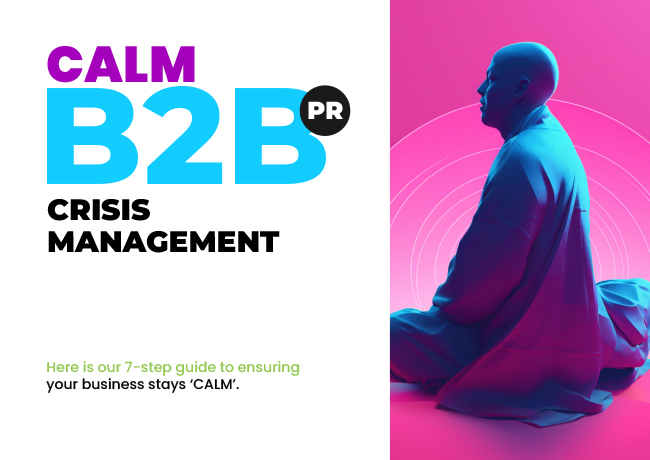
How should you use AI in crisis management?
Crisis management is a critical function for companies, whether they’ve invested in an in-house public relations (PR) team or a PR agency. In 2023 many are wondering if crises could be averted with the use of machine learning and artificial intelligence (AI) applications. Or, if we cannot avoid all crises, can we manage a crisis better, by involving AI?
I have been analysing the situation as it unfolds, especially from two major perspectives: efficiency and effectiveness.
Efficient responses to crises are crucial, faster can be better and waiting for a crisis to grow makes it more difficult to contain. Crucially, it’s all about timing. Therefore, efficiency is desirable. However, poor crisis management can be worse than no crisis management. For this reason, I will also dive into effectiveness in this article, with regards to using AI in crisis management.
Before I evaluate either, there is a moral question to ask ourselves. Is it “right” to use AI in our businesses?
On a personal level, I think AI should only be used when disclosed, in the same way an ad must be disclosed on an influencer’s social media. Moreover, there are few situations where I would condone AI acting alone, without human supervision.
Limitations of AI in crisis management
While AI undoubtedly empowers those who use it, the value of human expertise and decision-making in crisis management is irreplaceable.
The unique qualities that humans bring to the table include the ability to tailor crisis management messages to different stakeholders, deliver speeches with authenticity and empathy, and navigate complex situations that may arise during a crisis. No crisis taught us the importance of effective but sympathetic communications like Covid-19’s global spread. AI cannot, at the time of writing this, replicate the human touch, intuition, and emotional intelligence necessary for sensitive management of a crisis.
While it can automate responses to customer inquiries and gather data efficiently, AI lacks the capacity for empathy and human connection. Ongoing conversations during a crisis will inevitably require human intervention to address concerns and, many might say, it morally calls for a human to provide reassurance. AI cannot replace the nuanced communication requirements that PR teams use in high-stakes situations.
At EC-PR, we are people and that’s what makes the foundations of our agency, of any business. For the sake of not starting with a blank page, AI can get the plate spinning and save time getting a draft together, which is often the bit that takes up the most time, but AI will not be releasing press notes in lieu of my team in the near future.
The investment you make in a member of staff is in that person’s unique thoughts, ideas, curiosity, and human intelligence. No bot will be able to bring what a human can to something as crucial as a press release.
AI for scaling a crisis management response
The ability to think critically, assess situations, and make informed decisions is paramount in moments of stress. AI can liberate humans to focus on these timely jobs.
Many of us already automate certain tasks: we program an email or messenger to send during office hours to avoid bothering colleagues late at night; we accept suggestions of who to add or engage with on social media; we allow news sites to curate our feeds based on our previous behaviour. This can only be done thanks to machine learning, and automations that carry out repetitive tasks at scale, using data.
There are a handful of situations in which the same can be said during crisis management:
“AI is useful for PR teams, by enhancing situational awareness – providing real-time situation updates to facilitate more informed decisions,” said Andreas Wadström of Murphy Solution.
AI can certainly measure the reception of a post-crisis PR message for example. Public reception is often time-consuming to gauge and in PR, we need to have an ability to listen to the reaction carefully and respond when and where necessary. So, data gathering, organising, and clear presentation of such can allow PR teams to strategise more efficiently to respond to ongoing situations.
AI for assessing public sentiment
In PR, social listening is an essential part of what we do. Being able to accurately monitor the feeling and response of the target audience across key social media platforms enables us to gauge with our responses in other areas more effectively.
AI can provide valuable insights, helping PR teams monitor and respond to these evolving reactions effectively. By combining AI-generated data with current media trends, competitor analysis, and customer perceptions, PR professionals can make more informed decisions regarding brand image restoration or reinvention.
As a tool, AI can track updates on a crisis or provide perspective on a business’ current brand look and feel. Then, PR professionals can benchmark what the tool gives us against current media trends, competitor analysis, and customer perceptions. All of this can also be gathered and collated using machine learning!
Ultimately, it still needs to be a person drawing conclusions, however. There are nuances that must be considered and would be barely detectable to a machine, never mind automated.
In my eyes, AI can cut the time suck of gathering data for humans to make an informed decision. Additional insight is always welcome particularly if it’s from a different perspective, but AI is a tool and should be used as such. It is not a substitute for a person.
Known unknowns in AI crisis management
Tech proponents at Capestart suggest AI can help PR get ahead of major crises: “Organisations have traditionally reacted to a potential PR crisis only when it’s gained enough steam to get on their radar. AI can change this.”
What’s unclear is whether AI can step into gear over a crisis situation: can AI think about angles, decide which media to speak to and who not to speak to? Can AI decide optimum times to speak, when to gather information, and who to put forward as a spokesperson?
Nonetheless, AI can now advise on strategy, such as ideating ways to approach curve balls during a crisis. Again, this frees up PR teams to focus on maintaining a brand’s reputation in a new storm.
However, all decisions are critical when handling a crisis, and very difficult to measure with the information currently available to AI.
To elaborate, “ChatGPT doesn’t access a database of facts to answer your questions. Instead, its responses are based on patterns that it saw in the training data. So ChatGPT is not always trustworthy,” were the words of Jack Caulfield of Scribbr in February 2023.
While ChatGPT is only the “AI of the moment” and not the only offering available, this does signal how limited the information AI is accessing really is, compared to the collective knowledge of a PR team.
Moreover, your PR team looks at a crisis and knows that, for example, your VP of Product faced a similar situation at a previous company and handled it like a pro. They also innately know that your usual Marketing spokesperson will not be able to handle the resemblance a particular crisis has to a personal memory. AI cannot know this (yet).
AI in customer service, not crises
While we could argue whether crises need more of a human touch than customer service, one thing is for sure: PR teams are better positioned to assess the severity of a crisis and decide which tasks can be delegated to machines, simultaneously identifying those that necessitate human judgment and intervention.
By using AI in crisis management as a support tool rather than a decision-maker, PR teams can leverage its capabilities to inform responses, enhance outcomes, and protect brand reputation. It has the capability to offer options which, during a fierce storm, could be the calming voice.
AI is already being used to automate responses to questions from concerned customers. As an initial tool for addressing and responding to issues when timing is key, chatbots are an essential part of the process – there’s probably no going back.
Nonetheless, I’ve seen when lack of empathy creates more disruption than good so humans must programme very detailed fail-safes into their AI service. Human checks are essential in any communications not least because artificial intelligence is well-capable of actually creating a crisis, which KFC recently discovered when their automated twitter post celebrated a most offensive event!
Today, when absolutely anything is capable of going viral, one insensitive response from a bot to a concerned customer could make a crisis worse, so I personally would advise caution when trying to use AI to scale crisis communications for companies.
AI vs people for crisis management: Efficiency vs empathy
In short, AI can provide valuable support in crisis management for PR companies, but it cannot replace the nuanced decision-making, empathy, and expertise of human PR professionals.
At the time of writing, it seems that AI can provide plenty of efficiencies, if we’re willing to hand over the reins to a wild horse. This could go smoothly, the horse sprinting off into the distance at high speed. It could, just as easily, spread like wildfire, worsening an already critical situation.
Anyone is welcome to take their chances! If you want a sure-fire solution though, EC-PR is in your corner.


